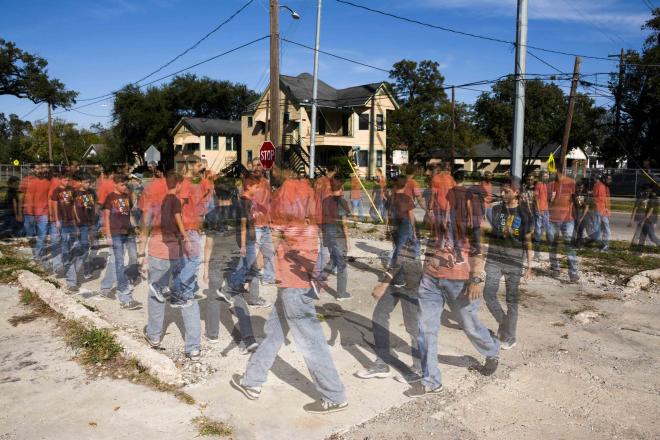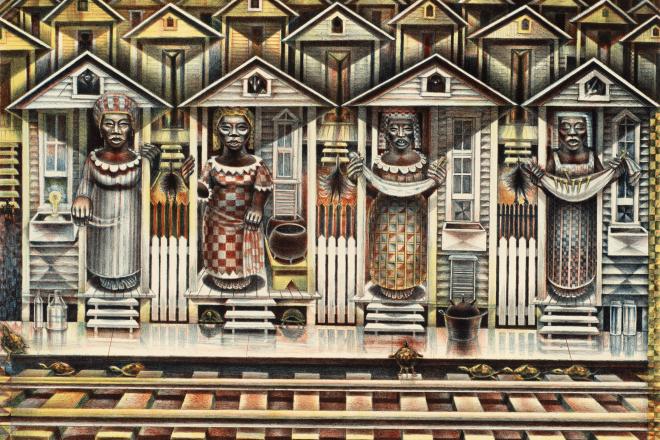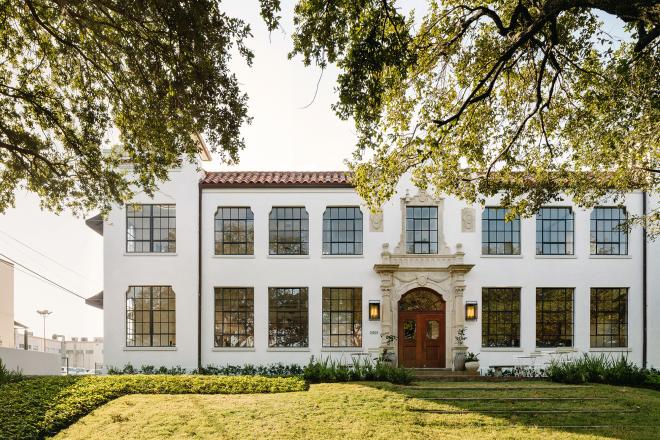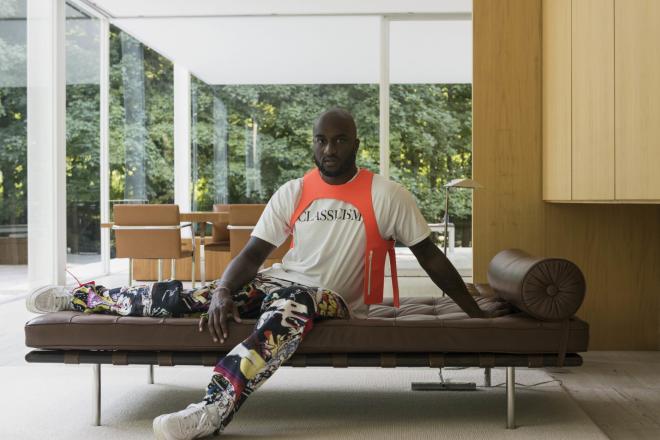
Visual Art Gallery at the old 1117 East Freeway location of Diverseworks. All black and white photos courtesy Bob Warren/rj warren photography
“Closing Time” was the last record played as the party wound down at DiverseWorks last week. Over one hundred people came out on Wednesday, October 24, to say goodbye to DiverseWorks’ second home, at “The Docks” (1117 East Freeway), where it lived from 1989 to 2012. (The first home, from its founding in 1982 until it caught fire in 1989, was at 214 Travis on Market Square.) The goodbye party was a bittersweet experience for many, as former executive directors, curators, interns, artists, board members, and audience members came out to connect with the space and institution which has nurtured much of Houston’s most radical, experimental expression for the past 30 years.
Melissa Bosch recalled that her first time at DiverseWorks had been to see Jello Biafra perform spoken word when she was a student at UH in the early '90s---and that she’d been taken there by frat boys, oddly enough. She went on to serve as an intern, and met her future ex-husband, performance artist Jim Pirtle, there.
Chuck Jackson reflected on his days in the Queer Artist Collective, an experimental performance art troupe composed of a revolving cast of seven to fifteen young people, from 1996 to 1999.

DiverseWorks closing party.
We were outsiders to the gay and lesbian community as it was conceived in the late 90s and we wanted to carve out a new space for thinking about sexual identity and gender identity. There was a national commodification of gay and lesbian identity; gay and lesbian people became a market niche, and there were some great things that accompanied that rise but there were also some problems with it. Those of us who were inhabiting alternative identities felt cheated, silenced, and co-opted by mainstream representations of our lives and we wanted to find a way to articulate our difference. We also wanted to combat the tendency to particularize the gay individual and work collectively to represent a collective queer subjectivity, and our subjectivity as a collective was problematic because it consisted of people from different ethnic and racial backgrounds, different educational backgrounds, different class and geographic backgrounds. So we used the theater space here to give voice to those differences.
Back then, ACT UP Gulf Coast and Queer Nation-Houston used to hold their meetings at DiverseWorks. Jackson and members of the Queer Artist Collective would attend performances and workshops put on by DiverseWorks with nationally recognized dancers and performance artists including Mark Dendy, Keith Hennesy, Pomo Afro Homos, Elia Arce, and Danielle Brazell from Sacred Naked Nature Girls.
Jackson communed with the space one last time by taking a contemplative walk through the backstage dressing rooms, which he capped by bursting through the stage door in one last grand entrance. There, in the top row of the theater seats he saw a man sitting alone.
“Sam?” he asked.
And indeed, Sam Jones, DiverseWorks’s former neighbor on the Docks who also served as the technical director, preparator, and theater manager from 1989 to 1999, was seated there, beside the tech booth where he’d spent countless hours over that decade.
“How many times did I wander out and ask Sam if he was up there?” Jackson said afterward, “And I just had that experience again, here, tonight.”

Former Diverseworks board presidents Lillian Warren and Kellye Sanford looking at former theater space.

Theater Control Booth

The Docks
Jones had been participating in his own exit ritual when Jackson walked in on him---he sat in silence for 20 minutes in the theater space and poured through his own memories. Afterwards, he rummaged through piles of refuse and came away with a lighting plot for an Annie Sprinkle show and a check, made out to him, dated February 15, 1993 from Southwestern Bell in the amount of six cents.
DiverseWorks is moving for many reasons---mainly because light-rail construction on Main Street has made the hard-to-find location almost impossible to find. Additionally, the Docks, which had once been a thriving community of artist studios and live/work space, are all but abandoned now, thus, almost everybody at the party expressed excitement at the prospect of once again plugging into a thriving arts community. Both Laura Lark and Jim Pirtle emphasized the connections they made with both local and national artists at DiverseWorks over the years, connections that often resulted in collaborations and other opportunities. The new location, at 4102 Fannin, will be within walking distance of the Isabella Court galleries, the Ensemble Theater, the Lawndale Art Center, Houston Center for Contemporary Craft, and much closer to The Museum of Fine Arts, Houston and Contemporary Arts Museum Houston.
One concern, however, is that the new 3,500-square-foot space will not contain a theater.
“Not to worry,” echoed current and former officials. The new space will allow DiverseWorks “to present art in a way that is responsive to the way that art is being made now. The boundaries between visual art work in a gallery and performance in a theater are much more fluid.” Coincidentally, the following weekend, The New York Times ran a story on exactly that---the rising popularity of performance art and the increasingly blurred boundaries between performance, visual, and installation art.
Another concern, stated by many who were not willing to go on the record, is that DiverseWorks will become less edgy, more mainstream, in its new environs. That, with arts funding waning, it will attempt to attract corporate donors by presenting “safer,” less “difficult” work. The move turns what used to be an artist-led community space into a brand, divorced of any local connection. It seems that little but the name will be carried over into the new space. Long-time DiverseWorks community member and artist Nestor Topchy, like many others, has a more zen approach to these inevitable changes.

Bryan “Funboy” Alchma's shoes. Color photos by Harbeer Sandhu.

The Docks' plan.


“If it stays the same it loses agency,” Topchy says. “If it changes, it stays alive and creates space for new mavericks. What starts off grassroots cannot stay maverick, and when everybody becomes a maverick it becomes a herd---then nobody is maverick.”
And Houston continues to see new innovative, experimental, underground art popping up---from Super Happy Fun Land to the Ponderosa and El Rincon Social, to events like CounterCrawl and the Lone Star Performance Art Explosion, which highlight these spaces and groups like the Continuum Collective, which pushes the boundaries of performance art.
Even the Docks are not completely empty. As the farewell party went on, musician and Docks-neighbor Bryan “Funboy” Alchma skated up and down the Docks with a friend and listed the many things he has acquired from DiverseWorks’ moving discard pile: projectors, TVs, computers, a tape player, tapes, a fan, and the white, patent leather Chuck Taylor Converse All-Stars he wore at that very moment.
Local history buff Ray Farahani described how the Houston rave scene had been born around the corner, adding, “I like the grittiness of this area. We’ll see how the new location goes.”
And finally, speaking of the new space, it hosted its first event when Aaron Landsman’s “City Council Meeting” lands there on Saturday, November 3, at 7:30 pm.
The space is still unfinished, but staff are excited that it has windows. The first show, Franklin Evans’s “houstontohouston” is scheduled to open on Friday, November 16.












